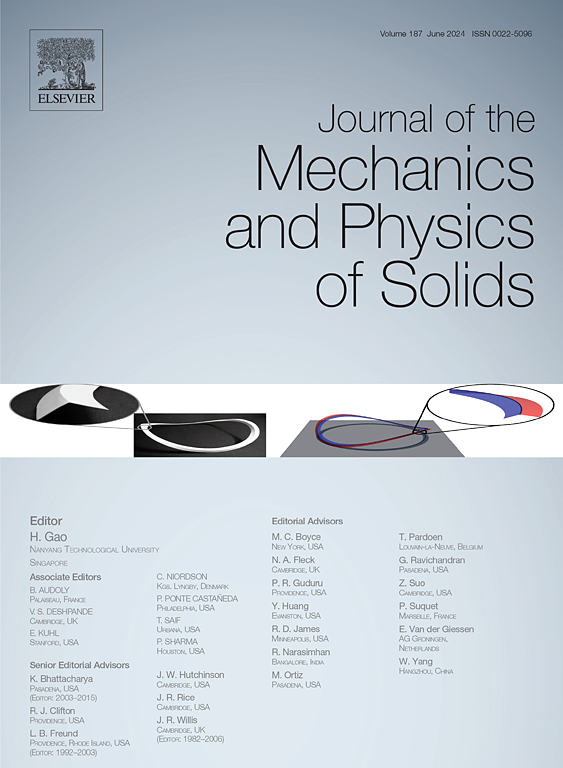基于仿生鱼骨和零泊松比晶格结构的飞机机翼变弧度结构
IF 6
2区 工程技术
Q2 MATERIALS SCIENCE, MULTIDISCIPLINARY
引用次数: 0
摘要
变形飞机是未来最先进的航空技术发展方向之一,而兼具刚性和柔性的变弧度机翼虽然技术难度大,但从工程可行性上看,是目前最可行、利润最高的航空变形机翼解决方案。本文提出了一种基于仿生鱼骨概念和零泊松比晶格结构的变弧度机翼结构(VCWS),使机翼的形状变化平滑、连续、显著,从而提高气动性能。结合仿生学原理、零泊松比晶格结构、伺服驱动执行机构和偏心杠杆传动机构,详细介绍了该结构的概念设计。制作了零泊松比晶格结构试件并进行了拉伸试验,通过数值模拟和解析建模验证了其良好的变形能力。在此基础上,设计并制作了VCWS,并进行了功能验证测试。实验结果表明,VCWS成功地实现了向上和向下的偏转。通过数值模拟和解析建模,对机翼偏转过程中的驱动力和变形进行了预测,预测结果与实验结果吻合,证明了设计的可行性和有效性。该结构为未来飞机的VCWS提供了更加灵活高效的解决方案,具有重要的工程应用潜力和科研价值。本文章由计算机程序翻译,如有差异,请以英文原文为准。

Variable camber structure for aircraft wing based on zero Poisson's ratio lattice structure
Morphing aircraft represent one of the most advanced aviation technology development directions in the future, and the variable camber wing that requires both rigidity and flexibility, although technically difficult, is currently the most feasible and highly profitable aviation morphing wing solution in terms of engineering feasibility. This paper proposes a Variable Camber Wing Structure (VCWS) based on zero Poisson's ratio lattice structure, enabling smooth, continuous, and significant shape changes in the wing to enhance the aerodynamic performance. By integrating zero Poisson’s ratio lattice structure, servo-driven actuators, and eccentric lever transmission mechanisms, the conceptual design of this structure is described in detail. Specimens of zero Poisson’s ratio lattice structures were fabricated and subjected to tensile testing, and the excellent deformation capability was validated through numerical simulation and analytical modeling. Based on this, a VCWS was designed and fabricated, followed by functional validation tests. Experimental results show that the VCWS successfully achieves both upward and downward deflection. Through numerical simulation and analytical modeling, the driving forces and deformation were predicted, and the results matched the experimental results, proving the feasibility and effectiveness of the design. This structure offers a more flexible and efficient solution for VCWS in future aircraft.
求助全文
通过发布文献求助,成功后即可免费获取论文全文。
去求助
来源期刊
CiteScore
9.80
自引率
9.40%
发文量
276
审稿时长
52 days
期刊介绍:
The aim of Journal of The Mechanics and Physics of Solids is to publish research of the highest quality and of lasting significance on the mechanics of solids. The scope is broad, from fundamental concepts in mechanics to the analysis of novel phenomena and applications. Solids are interpreted broadly to include both hard and soft materials as well as natural and synthetic structures. The approach can be theoretical, experimental or computational.This research activity sits within engineering science and the allied areas of applied mathematics, materials science, bio-mechanics, applied physics, and geophysics.
The Journal was founded in 1952 by Rodney Hill, who was its Editor-in-Chief until 1968. The topics of interest to the Journal evolve with developments in the subject but its basic ethos remains the same: to publish research of the highest quality relating to the mechanics of solids. Thus, emphasis is placed on the development of fundamental concepts of mechanics and novel applications of these concepts based on theoretical, experimental or computational approaches, drawing upon the various branches of engineering science and the allied areas within applied mathematics, materials science, structural engineering, applied physics, and geophysics.
The main purpose of the Journal is to foster scientific understanding of the processes of deformation and mechanical failure of all solid materials, both technological and natural, and the connections between these processes and their underlying physical mechanisms. In this sense, the content of the Journal should reflect the current state of the discipline in analysis, experimental observation, and numerical simulation. In the interest of achieving this goal, authors are encouraged to consider the significance of their contributions for the field of mechanics and the implications of their results, in addition to describing the details of their work.

 求助内容:
求助内容: 应助结果提醒方式:
应助结果提醒方式:


